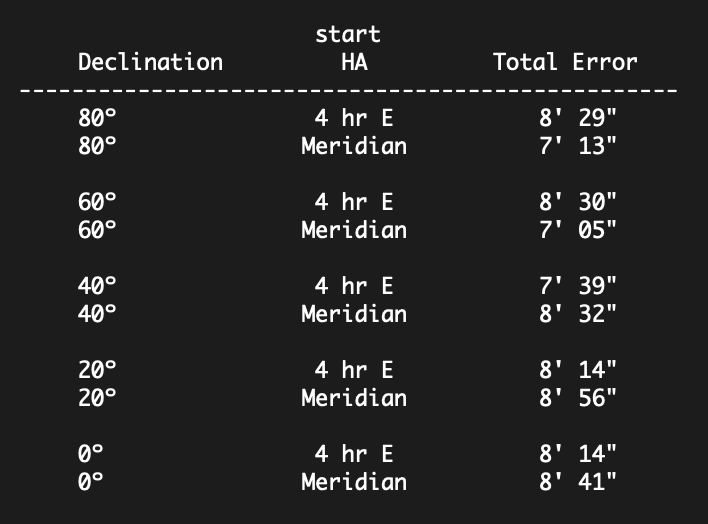I just made an attempt to quantify the accuracy of the All-Sky Polar Align process in Experimental Feature of ASIAIR 1.8.3 (Firmware 9.12).
I used my MountSim program (http://www.w7ay.net/site/Applications/MountSim/) which is a virtual mount that has no imprecise mechanical parts. The simulated focal length is 158mm (ASI174mm mini pointed at an iPad Pro M1's that is used as an external display).
The measurement involves a perfectly aligned mount (for my Latitude of 45º 35' North). After a polar alignment (without adjusting altitude or azimuth bolts), a perfect algorithm should return a polar alignment of zero. Any non-zero result is an error from the algorithm, residual plate solve error, star centroid error, bad atmospheric refraction error, etc).
To confirm my older measurements, I reran the original Polar Alignment algorithm in Firmware 9.12, at 90 degree declination and obtained an error of 10" (10 arc seconds).
Like the original algorithm, the All-Sky Polar Align in ASIAIR uses only RA axis slewing. Unlike a GOTO command to the mount, an RA slew command ensures that the declination axis of the mount has no movement at all. Unlike the original method that rotates the RA axis westward by 4 hours (60º) to make two plate measurements, the All-sky method makes three plate solves about 1.5 hours (22.5º) apart, for a total of 45 degrees of slew.
And unlike the original method, the All-Sky method allows you to use declination angles that are more than 30 degrees from the pole.
Warning: because the all-sky method works with arbitrary declination angles, an RA slew that crosses the Meridian can cause telescope parts to crash into the tripod or pier (slews do not enforce Meridian flips).
(I am willing to wager good money that some 1,2,3 Simpleton will eventually crash his/her telescope into a tripod when using the all-sky method.)
Because of the possibility of a real telescope hitting the pier, I don't simulate with starting Hour Angles that crosses the Meridian, even though the virtual mount will not suffer any damage. I either start at the Meridian (Pier side east) or hour angle of -4 hours (Pier side west, OTA pointed 60 degrees east of the Meridian).
So, here is the result (remember that the original method gave me 10" of error with the same firmware version):

Caveat Emptor.
Chen